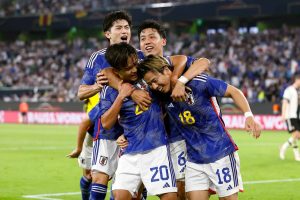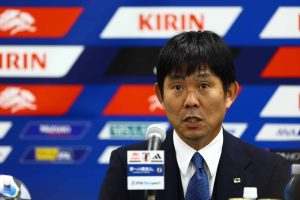
In the previous tournament in 2019, Japan lost 3-1 to Qatar in the final / photograph: Miki Sano
Starting with their first triumph in 1992, Japan’s four Asian Cup victories are the most in the tournament’s history – Overcoming many fierce battles, Japan has achieved the status as a continental powerhouse
The Asian Cup, first held in 1956, is now in its 18th edition.
Japan first participated in the 1988 competition in Qatar. On that occasion Japan failed to win a single game in the first round of the five-team tournament, drawing once and tasting defeat three times and thus having to leave the competition early.
However, Japan achieved a remarkable feat when hosting the tournament in 1992. With the J.League due to start the following year and with public interest in football growing, Japan topped their group league, in which they faced the UAE, North Korea, and Iran. In the semi-finals, Japan defeated China 3-2 thanks to Masashi Nakayama’s winning goal, before defending Takuya Takagi’s 36th-minute strike in the final to emerge as 1-0 winners against Saudi Arabia. The team had achieved their long-cherished dream of winning the tournament for the first time.
In the 1996 tournament in the UAE, Japan only made it to the last eight after losing to Kuwait in the quarter-finals, but in 2000 they were again able to bask in the glow of victory, with Philippe Troussier’s team showing overwhelming strength throughout the tournament, which came just two years before they joint-hosted the World Cup with South Korea.
Japan comfortably progressed through the group stage, beating Saudi Arabia 4-1 and Uzbekistan 8-1, and also won 4-1 in the quarter-finals against Iraq. The volley by Hiroshi Nanami (current assistant coach of the national team) in that match is still talked about today.
In the semi-finals, Japan battled to a hard-fought comeback victory over China, before once again taking on Saudi Arabia, who they had beaten comfortably in the group stage, in the final. Despite being outplayed, Japan managed to hold on to a first-half goal from Shigeyoshi Mochizuki to win the tournament for the second time, 1-0.
The 2004 tournament was held in a difficult environment in China, where anti-Japanese sentiment was on the rise and the players were constantly booed.
Nevertheless, Japan, the reigning champions coached by the legendary Zico, showed resilience in the face of adversity. Led by No.10 Shunsuke Nakamura, the team made it through their group undefeated, with the knockout round producing a series of dramatic battles.
First up, their quarter-final against Jordan went to a penalty shoot-out, with Nakamura and Santos Alessandro failing in quick succession due to the poor condition of the pitch. Captain Tsuneyasu Miyamoto appealed to the referee and the shoot-out was moved to the goal at the other end of the pitch.
After two more misses, Japan were backed into a corner, but it was here that their guardian, Yoshikatsu Kawaguchi, stepped up to the plate. He stopped kick after kick from the opponents, who would have won the game if they had scored, leading Japan heroically into the last four.
In the semi-final against Bahrain, Yuji Nakazawa scored a crucial diving header in second-half stoppage time after Japan had trailed 3-2. This gave Japan the momentum to win the penalty shoot-out 4-3 after extra time, with Keiji Tamada converting the crucial spot-kick.
In the final against hosts China, Japan refused to succumb to the pressure as the away side and delivered a 3-1 victory to claim the title for the third time.
In 2011, Japan was led by European club players such as Shinji Kagawa, Keisuke Honda, and Yuto Nagatomo
In 2007 Japan was aiming for a third consecutive crown, but lost to Saudi Arabia in the semi-finals and then also fell to defeat against South Korea in the third-place play-off after a penalty shoot-out. However, in 2011, under coach Alberto Zaccheroni, the team bounced back impressively to win the championship for the fourth time, the most in the competition’s history.
The team that year was led by European club players such as Shinji Kagawa, Keisuke Honda, and Yuto Nagatomo. They got off to a difficult start in the group stage with a draw against Jordan but beat Syria in the following match thanks to a Honda penalty before Shinji Okazaki struck a hat-trick in a 5-0 win over Saudi Arabia.
After a 3-2 quarter-final win over Qatar, including two goals from Kagawa, Japan beat arch-rivals South Korea in a penalty shoot-out in the semi-finals to advance to the final.
There, they faced Australia. After 90 minutes of goalless play, the drama arrived in extra time, when Tadanari Lee met Nagatomo’s 109th-minute cross from the left with a powerful left-footed volley to score a sensational winning goal. 1-0, a hard-fought victory, and the fourth time at the top of the Asian table.
However, Japan has not won the tournament since. In the 2015 tournament in Australia, they lost to the UAE in the quarter-finals after a penalty shoot-out, and in the previous tournament in 2019, they were beaten 3-1 by Qatar in the final.
This year’s competition, which is being held in Qatar, features five players who know the frustrations of that defeat (Wataru Endo, Junya Ito, Takumi Minamino, Ritsu Doan and Takehiro Tomiyasu). Above all, it will be a tournament of revenge for coach Hajime Moriyasu, who has led the team since then.
Japan haven’t had things all their own way so far, losing to Iraq in the group stage, but they finished in second place nevertheless to advance to the knockout stage.
Aiming to win the tournament for the fifth time, can Japan again make it to the Asian summit? The next hurdle comes in the Round of 16 match against Bahrain on 31 January.


